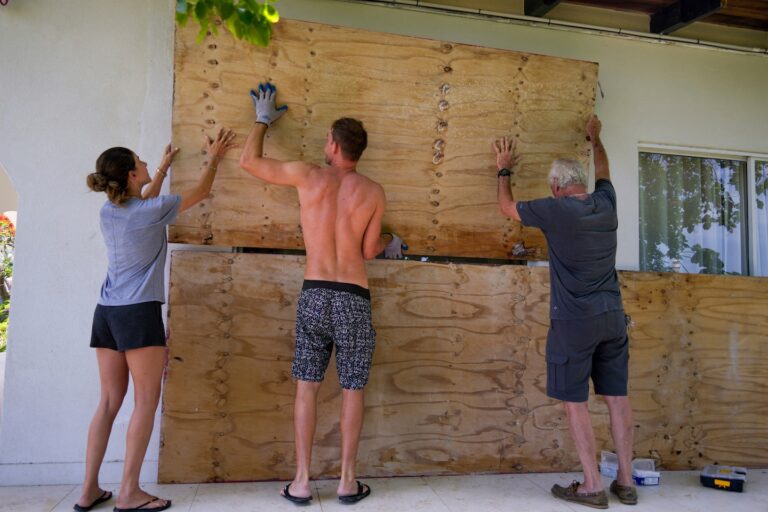Hurricane warnings were issued for Barbados, St. Lucia, St. Vincent and the Grenadines, Grenada and Tobago, while tropical storm warnings extended as far north as the Dominican Republic and Haiti.
“All preparations must be completed as soon as possible today,” the Hurricane Center said Sunday.
According to the Hurricane Center, Beryl rushed toward the Windward Islands, including Grenada, Dominica, Martinique, St. Lucia and St. Vincent, on Sunday evening. Life-threatening winds and storm surge are expected to hit the archipelago early Monday.
Researchers have been warning for months that the 2024 Atlantic hurricane season could be a record season, and now it is: There is no precedent for a storm to intensify so quickly, nor reach this force, in this part of the ocean in June. . The archives date from 1851.
Grenada entered a state of emergency late Sunday as a precaution against the approaching storm, with Prime Minister Dickon Mitchell urging the island’s 125,000 residents to stay home. St. Lucia’s Prime Minister Philip J. Pierre said a nationwide lockdown in the country, home to about 170,000 people, would begin at 8:30 p.m. Sunday. The St. Vincent and the Grenadines Meteorological Service issued a flash flood warning to its 100,000 residents.
In Bridgetown, the capital of Barbados, Doriel Gill-Skinner spent Sunday telling others about a neighborhood shelter for those in need, she told The Washington Post. The storm wasn’t expected to hit the island for several hours, but by early afternoon she had packed her grab-and-go bag of nonperishable food, water and a change of clothes and was busy preparing her neighbors.
“The mood in the community is calm and confident,” she said. “We are taking the storm seriously and preparing for it.”
On Sunday afternoon, Michael Tiller looked out at the blue sky and calm, clear water from the terrace of a rented vacation home in Barbados. “You can’t really say a hurricane is coming,” the Michigan resident said. “It’s a beautiful day here.”
Tiller plans to hunker down as soon as the winds pick up. Property managers at the home he shares with his family during the week closed the windows and glass doors earlier Sunday. The family is bracing for high winds and power outages, but Tiller said he’s not too worried. The family plans to return to the United States on Wednesday.
Nauman Khan, visiting from Toronto, spent most of Sunday exploring Barbados with his wife and two children. Like Tiller, Khan said there was no indication a major storm was on the way.
“It was sunny all day, with a light breeze – a typical Barbadian day,” Khan said.
But the wind began to pick up late in the afternoon and his hotel, located on the southern end of the island, informed guests that the on-site restaurant would stop serving guests on site. Guests were asked to spend the rest of the evening in their rooms.
“I didn’t see any panic,” Khan said. “The DJ is still playing. The bar is still open.”
Beryl intensified quickly. The hurricane intensified from a tropical storm to a Category 3 hurricane in 36 hours, intensifying 75 mph (120 km/h) during that time. This level of rapid intensification has never happened in June and has only happened twice in July, according to DTN Weather researcher Sam Lillo. Beryl reached Category 4 intensity on Sunday morning.
There is a strong link between rapid intensification – the strengthening of hurricanes – and human-induced climate change. Ocean waters are running 3 or 4 degrees above average, which is more like August than June.
Until now, the Atlantic had seen only two major hurricanes, rated Category 3 or higher, in June: Audrey in 1957 and Alma in 1966. The main Atlantic development region, between northern South America and Africa, was considered inhospitable to major hurricanes in June – until now.
We expect Beryl to slam the Windward Islands with winds of 130 mph or more. The Hurricane Center expects a storm surge of 6 to 9 feet, as well as 3 to 6 inches of rain.
According to the Hurricane Center, Beryl is expected to remain powerful as it moves across the southeastern and central Caribbean Sea Monday through Wednesday.
At the center of that path, Grenadians were preparing for the worst and hoping to avoid a repeat of Hurricane Ivan in 2004, which killed at least 37 people and damaged 90 percent of the island’s homes.
Kitaka Chakumba Mawuto remembers that during that storm, he and his family saw the roof fly off their house before rushing to a neighbor’s house.
“It was traumatic, but it brought us closer together,” Mawuto, 30, said. His family had no idea what awaited him under Ivan, but he is better prepared now. He hopes the authorities will do so too, he said.
Several islands north in St. Lucia, Rhyesa Joseph said Sunday she had prepared as much as she could, making sure all her electronics were charged and putting away essentials. She is more concerned about the safety of others on the A 28-mile-long island and what the storm will leave behind, she said.
“I am very concerned about the economic impact of the hurricane, the damage to infrastructure and the food insecurity it could cause,” Joseph said. “We know what happened to our neighbors because of hurricanes, and we have experienced Hurricane Tomas and other storms ourselves.” Hurricane Tomas killed at least eight people in the Windward Islands before killing 35 people in Haiti in about a week in 2010. It caused an estimated $336 million in damage in St. Lucia.
Always, Sunday afternoon, Joseph said it was “a particularly beautiful day” and the weather was sunny and warm.
“Literally the calm before the storm,” she said.
Jiselle Lee contributed to this report.


